#working class fashion
Text

#The Edwardian Teddy Boys#original Teddy Boys#working class styles#working class fashion#styles not for sale#on the common#The Westfield
0 notes
Text
Someone needs to do an analysis on the way the Kung Fu Panda movies use old-fashioned vs. modern language ("Panda we meet at last"/"Hey how's it going") and old-fashioned vs. modern settings (forbidden-city-esque palaces/modern-ish Chinese restaurant) to indicate class differences in their characters, and how those class differences create underlying tensions and misunderstandings.
#This is neither a criticism nor a compliment of that artistic choice#I just think it's really interesting#Like even looking at the Five:#Tigress talks in an older style than the others because she was mainly raised at the Jade Palace#While Mantis talks like Joe-schmo off the street because he *was* a streetfighter and an ordinary guy#Shifu and even Tai Lung talk like they're from an old-fashioned novel or kung fu movie#Po talks like a modern guy you'd meet working in a twenty-first century family restaurant#Part of Tigress's initial disdain for him in the first movie is clearly because she considers him to be low-class/a commoner#(And therefore an intruder into the world of the Jade Palace and the rest of the Kung Fu masters which appears to be semi-noble).#Shen looks genuinely off-put and disgusted when he has to respond to Po's greeting with a “...hey.”#And when Po wants to appear more legitimate as a warrior he adopts a more “legendary”/old-fashioned way of speaking.#In the aesthetic language of KFP old fashioned=noble/upper class and modern=common/lower class.#This translates entirely naturally—I think especially to an American audience—but it is wild once you notice it#Because you realize: “Hang on—shouldn't *all* these characters be talking like they're living in the medieval era?”#“And what does it mean that they're not? What is the movie attempting to convey with this—probably entirely subconscious—artistic choice?”#kung fu panda
863 notes
·
View notes
Text
I watch a fun IG reel of a maid getting dressed in 1790 vs. 1890. it's great! both maids are in practical, period-typical outfits with a few simple aesthetic touches because Humans Like Looking Good regardless of social class. you can tell they are maids because they put clearly functional aprons on, and the 1890s one is wearing a uniform-style cap. also the caption says they are. love it
I scroll down
the top comment: "but what did POOR women wear? you only ever show rich people's clothes!"
#dress history#fashion history#historical costuming#perhaps...working women...had nicer clothes than you realize?#perchance they...did NOT go about in rags?#shocking to even consider I know!#also if they're not being educational historical costumers don't owe you working-class ensembles in their fun personal hobby#but that's another conversation#(I'm a normal person 24/7! let me be a countess for a while!)
795 notes
·
View notes
Text
Tbh I think the fast fashion conversation should involve poor ppl but not in any way in the form of shaming but more like: “you are being taken advantage of by large corporations that have women and children enslaved to make crappy clothes in excessive amounts that have literal lead that will damage ur body in serious ways that ur pressured to buy via influencers that form a parasocial relationship with you and don’t care about you to overconsume them in large amounts that won’t last and have to be thrown away at some point and all that ends up fucking the environment. Plus, the cycle of consumerism is damaging to ur finances to keep u in poverty and mental health of always wanting more but never satisfied.”
I am saying right now you don’t need to throw out fast fashion items you currently own, if they fall apart, they can be repurposed. I am also saying I’ve been guilty of shopping fast fashion but am also making a commitment to eliminate fast fashion purchases and mindset in my life. The root cause of these fast fashion corpos to keep doing what they do is purely based on you buying from them and you, the consumer in this capitalist world, have the power to change that. Obviously there’s little you can do to avoid big oil or buying things made with prison labor without serious direct action but the fashion industry is one that is by design meant to be maintained by mindless consumerism and overconsumption.
If you are poor, please do whatever within ur means to avoid fast fashion, whether it’s buying from thrift stores other than goodwill and just buying less clothes and focusing on more important things in ur life. A better tomorrow is still possible if you allow it.
#mine#gothgoth#deathrock#punk fashion#sustainable fashion#sustainability#trad goth#goth fashion#slow fashion#fuck fast fashion#punk#goth#anarcho punk#anarchism#anarchy#anarchist art#anarchist#anarchopunk#anarchofeminism#leftist theory#punk culture#goth culture#punk rock#counterculture#boycott divest sanction#boycott#working class#diy or die#diy#diy culture
73 notes
·
View notes
Text


#working class fashion babeyyyyy!!!!!!!#hell yeah 😎😎#historical fashion polls#fashion poll#historical dress#historical fashion#dress history#fashion history#fashion plate#19th century#19th century fashion#19th century dress#early 19th century#1820s fashion#1820s#1824
69 notes
·
View notes
Note
h-how do you ever finish any of your work? genuine question because you seem to be productive despite your agreste syndrome and I need to learn your ways. but also how do you ever finish any of your work
unclear. last night i stayed up and finished a report worth 25% of my grade at about 5am, arrived on time for my 9am lecture, and spent about half of it zoned out while thinking about seventeen year old emilie agreste. and i was one of the most active participants in the class discussion
#in some ways it IS the move to go to grad school right out of undergrad#because your body can still sort of operate like a college kid#i’m on about 3ish hours of sleep rn and this morning it felt SO over but now i’ve eaten something and we’re so back#i also don’t really do caffeine. except sometimes i’ll go get one of those panera death lemonades#i might be able to snag a short nap before work#but anyway about seventeen year old emilie. i was thinking abt how she was in that movie solitude and adrien said she was seventeen#WAIT. NO. HE SAID SHE WAS SEVENTEEN IN THAT PHOTO ON HIS DESKTOP NOT IN THE MOVIE#well. okay whatever i’m gonna tell you what i was thinking about anyway#OKAY i’m back i just checked the wikipedia page and then i watched the end of gorizilla. to make sure i’m not lying. because i’m normal.#anyway i was thinking about the solitude film and how it’s super rare and old and obscure and whatever. and how apparently#emilie wrote it herself and andre produced it#and i’m thinking about how gabe was discovered by audrey and that’s how he got his start in the fashion industry#so now i’m like?? did gabe and emilie first meet on the set of solitude? because gabe was designing costumes or whatever?#and that’s how audrey found him? have people already thought about this??#also i just checked and it doesn’t say emilie’s last name in the credits and also it’s ‘graham films’ with the twin rings logo m#so i’m assuming she’s still emilie graham de vanily at that point#anyway it comes back to seventeen year old emilie because i started imagining seventeen year old runaway emilie having her new life in pari#after escaping her british nobility life#and the first thing she does is write and star in an original movie. of course.#and she meets this repressed bisexual punk upstart costume designer who is so the opposite of everyone she’s ever known#and he’s immediately so unhealthily obsessed with her. which she appreciates.#and then they proceed to have the most toxic doomed evil relationship of all time#also she gets cheated because once gabe gets money he represses himself SO hard that he is now exactly like all the people emilie grew up w#but at least he’s still obsessed with her#this is what i was thinking about during class today. i don’t know how i get anything done either.#ml#anna rambles#asks
110 notes
·
View notes
Note
Hi! So I’m doing a personal art project on fashion in the 1890s, and I am struggling. Like a lot. I created a Pinterest board of a bunch of 1890s dresses, problem is I’m having a hard time identifying the uses for some of them. I know that a Walking dress is a type of Day Dress but how exactly would one differentiate the two? What exactly would be the physical differences between a Walking dress and a Day dress?
And did everyone have walking dresses? Or was the more of an ‘upper class’ sort of thing?
I understand the struggle. It was quite hard to parse out at first for me too since the Victorian dress etiquette was pretty complex. Fortunately I have made a post about that specifically for 1890s. If it doesn't answer all your question or you want me to specify something, feel free to sent another ask! I used examples from different years of the decade to make it more applicable to the whole decade but it should be remembered that there was changes to the silhouette thorough the decade and every type of dress would be adapted to the shifts in the fashionable silhouette.
Though as I point out in the post it focuses on the upper class. For the working class and to some extent middle glass it was a little different. The working class did not participate in the high society events, but many middle classes could at least to some of them, and working class women worked outside of the house too, while married middle class women generally didn't. Young unmarried middle class women did often work, for example as secretaries and shop assistants in respectable establishments. Working women didn't spend their days receiving guests at tea parties or attending them, so they didn't have tea dresses, nor did they generally have evening gowns which would be required in formal high society events. They might have a dinner dress though if they were well off, which was the least formal of evening gowns. Middle class women would generally have these. Working class and the casual middle class day dress resembled much more the walking dress of the upper classes than their other day dresses. They would have a church dress that would be a little fancier day dress for church and usually even fancier day dress for formal functions, like weddings.
Here's working class women in their work attires that were practical day dresses and aprons usually.

And here's middle class women in fairly similar dresses.
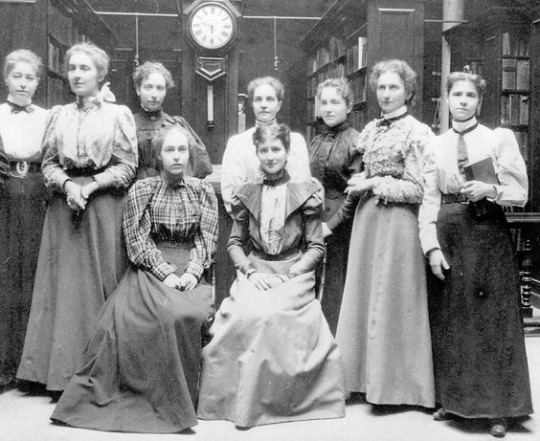
Different types of day dresses
Maybe I should expand more on the differences in day dresses and how walking dress relates, since while I talk about day dress and walking dress separately in the linked post, I don't fully explain the whole day dress thing since I did need to simplify. Day dress was not a specific dress, but quite a broad category of dresses that were used in different situations thorough the day. They are quite hard to differentiate sometimes, mostly because they weren't really that strictly different from one another. To understand why one dress was used in one situation, we need to understand the dresses in the casual to formal scale. Usually casual is looser, more practical, less elaborate and more covering but has shorter hem and the opposite apply to more formal.
When staying at home, people would be in their most casual clothing, but the level of formality would rise when receiving guests. Leaving home would require higher level of formality, but how high would depend on what you were going to do and who would see you doing it. This is why visiting gown is more formal than the dress the hostess would receive their visitor in. Close family members and friends could be casually received outside specific events during the day and a casual house dress or tea dress was acceptable for that. Afternoon tea was an important social event for upper and middle class women, and it would be slightly more formal occasion, but still for family and friends and therefore somewhat casual. Visiting dress were on the formal end of the afternoon dresses, but more casual versions of it could be used to go see a close friend or family member in a more casual way. Carriage dress was worn for open carriage rides, which were social events for the upper class. There they would be seen prominently by their whole community while they socialized in the carriage among their peers. Carriage dress was therefore very formal and elaborate, often had a trail and usually had a cloak as the wind might get cold. Promenade dress was for walks in a park. This was different from an actual walk, as the upper class people would go to a park to be seen and to socialize. Promenade dress was then somewhat formal, though less than most visiting dresses or carriage dress.
Here's first an example of a quite elaborate visiting dress from 1894-95 and then carriage dresses, first image from 1894, second from 1891.
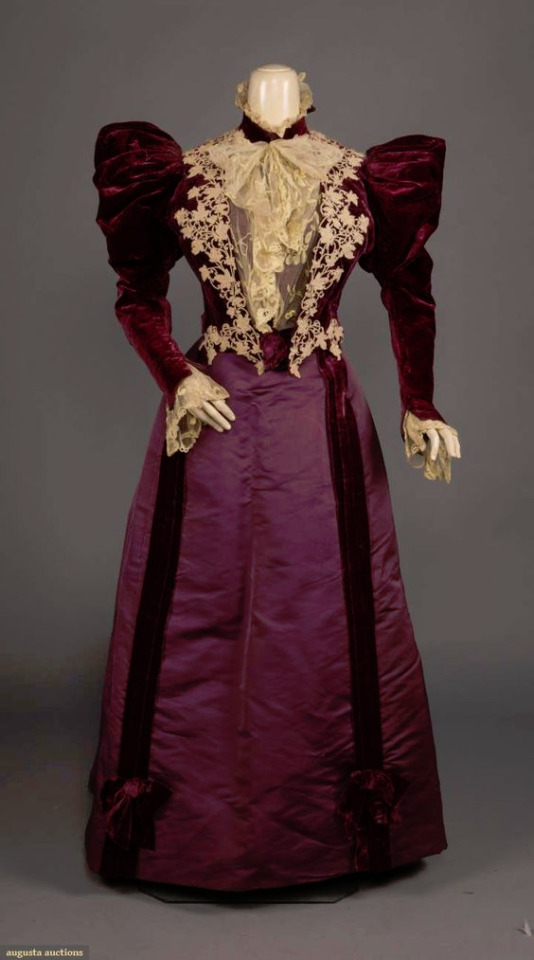


Walking dress was the least formal of the dresses an upper class person might wear outside the house (excluding sports dresses). It was used by upper class people for city walks and traveling, but as I said earlier the practical day dresses of middle and working class were very similar to it. It was practical and simple. It had shorter hem, it was made from sturdy materials, often wool and it was usually tailored. Dress Reform Movement, which was a moment among the first wave feminists, advocated among other things for tailoring in women's clothing, arguing it was more practical. The trend begun in 1880s and it's really most prominent in walking dresses and sports wear of 1890s. Which it why the walking dress typically has a lot of elements from men's fashion. Unlike the other day dresses, which were rarely tailored and had usually just the skirt and the bodice, the walking dress had a skirt, shirtwaist, tailored jacket and sometimes a waistcoat and a tie or bow. Sometimes a walking dress is hard to distinguish from a promenade dress. Promenade dress was more elaborate and while it usually had a shorter hem than for example carriage dress, it wasn't as short as for a walking dress and it might even involve a bit of trail. The things is promenade dress and walking dress probably had a lot of overlap.
Here's fashion plates showing promenade dress styles, first from 1896, second from 1898, both conveniently showing an elaborate dress and a tailored look that's easy to get mixed with a walking dress, and possibly would have been used as such in some cases.
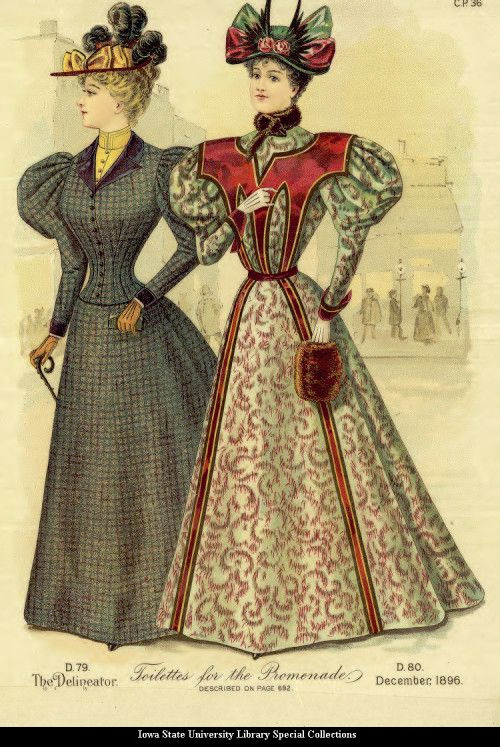

Here's walking dresses shown in a picture from 1899 (note the early photoshop to make the waist smaller), a fashion plate from 1896 and a painting from 1897. Really the main difference is the hem of the skirt to the promenade dresses of tailored style.



Shirtwaist
I will mention on it's own shirtwaist too, since it highlights a lot of the class differences and how they showed. The shirtwaist, or blouse waist or sleeve shift, is a hard garment to pinpoint as it was used for many different purposes by different people. It was one of the first garments to be mass-produced and therefore very affordable. It was also loose and unfitted by nature and so easy to move in. For these reasons it was used with a practical skirt by working class and middle class women as casual wear. The outfit was sometimes used with a jacket similar in style to those of walking dresses, making it practically indistinguishable from a walking dress. Here's for example pictures of working women class women wearing shirtwaists at work and at town shopping (the other picture could be of middle class women too).


As tailored styles influenced by men's fashion became popular, so became shirtwaists. At the same time sports were becoming popular and sportswear was highly influenced by this tailored trend. Shirtwaist being light and loose was perfect for sports and was used by upper and middle classes for tennis, golf and cycling for example. (I'm working on a post about the history of tennis ensemble where I go deeper into this.) Because of it's very casual nature, it was not considered suitable for the upper classes in most situations outside sports. As seen above it was part of the walking dress for the upper class, but in that situation it was used under a jacket. Young fashionable progressive women, who were often called the New Woman, started using it in their morning dresses and then even casual day dresses.
Here's first a picture of tennis ensemble from latter half of 1890s, a picture of young women from 1898 and a fashion plate from 1898.
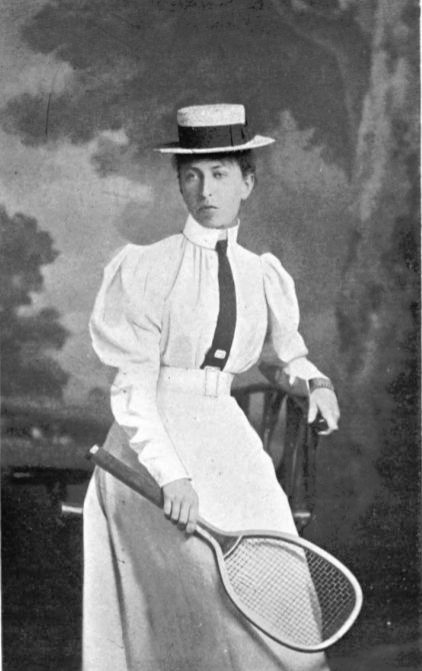

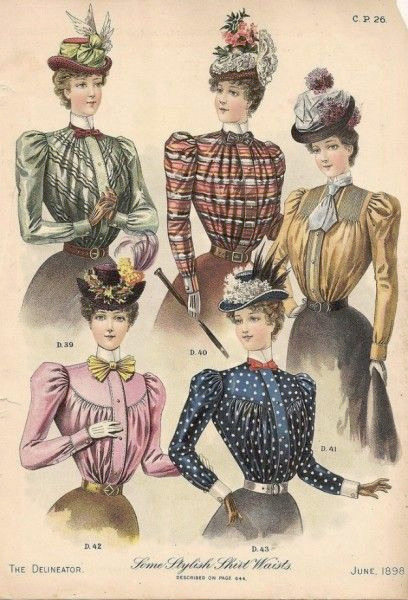
I have a pinterest board of primary source examples for Victorian fashion, where I've made a rough divide between different periods of the era and different types of dresses inside every period. It's not fully organized yet and at least for now the types of dresses are divided very roughly into day dresses, evening dresses, sports ensembles and toilette. Toilette is a vague enough term so I used it here to include basically any dress used exclusively at home. The categories are maybe not granular enough to be helpful for you here, but I'm linking it here in hopes it would be of some help.
#answers#historical fashion#history#fashion history#victorian fashion#dress history#1890s fashion#victorian day dress#1890s day dress#day dress#working class dress#anon
185 notes
·
View notes
Text


redraw of a character assignment I had last year
#i don’t remember if I ever posted the original on here but I hope not cause that shit looks ass lol#it was probably one of my least favorite drawings I did for that class even though it was so simple and I had a solid idea for it#it’s definitely an improvement but there’s definitely stuff here I need to work on#like contrast and better lighting and backgrounds and all that#but I’m happy with how it came out <3#she’s a trans woman drag queen btw#very 80s 90s winter fashion inspired#I think I leaned too heavy on that for the original tho#art#digital art#my art 🦷#digital painting#drag queen#trans woman
71 notes
·
View notes
Text
theres a lot wrong with kryptonian society and culture but i gotta say they did at least one thing right and its the capes. everyone just wears capes, all the time. we could learn from them
#rimi talks#of course the abhorrent treatment of their working class is another issue entirely but hey#i do find it fun that at least kandor in new krypton stuff is not particularly like. sexist at least#which is a low bar but i mean with comics inventing societies i just kind of expect them to go AND HERE. THEY TREAT WOMEN LIKE SHIT#ofc the gendered names (women taking their father's name as their surname when men don't) is... hmm#but i can work on it. i can fix that. i think it'd be fun to lean into kryptonians with different takes on gender anyway.#BUT that's all off topic my point is. capes? fashionable. wish that were us
60 notes
·
View notes
Text
“Like everything based on the writings of Karl Marx—seeing oppressors and colonial struggles everywhere—DEI was doomed to fail. The uniformity of thought known as intersectionality, fostered by DEI, meant all oppressed people must support all others who are oppressed. But that idea burst on Oct. 7 when Hamas raped, murdered and kidnapped Israelis. Many liberals, especially Jewish ones, couldn’t support genocidal “colonized” terrorists. Pop! The long march is in retreat.
By the way, ESG, or investing based on “environmental, social and governance” principles, peaked last June, when BlackRock CEO Larry Fink said he would stop using “the word ESG anymore, because it’s been entirely weaponized.” Never mind that performance of ESG funds has been sketchy and that BlackRock had been adding the label “sustainable” or “ESG” to funds and charging up to five times as much. Then a study published in December by Boston University’s Andrew Kingfound “no reliable evidence for the proposed link between sustainability and financial performance.” Pop!
Most offensive to me was DEI’s devious underlying agenda: societal design. 𝐁𝐥𝐢𝐧𝐝𝐞𝐝 𝐛𝐲 𝐟𝐚𝐧𝐚𝐭𝐢𝐜𝐚𝐥 𝐝𝐞𝐯𝐨𝐭𝐢𝐨𝐧, 𝐚𝐜𝐭𝐢𝐯𝐢𝐬𝐭𝐬 𝐰𝐞𝐫𝐞 𝐩𝐚𝐰𝐧𝐬 𝐟𝐨𝐫 𝐭𝐡𝐞 𝐜𝐚𝐮𝐬𝐞 𝐨𝐟 𝐫𝐞𝐬𝐡𝐚𝐩𝐢𝐧𝐠 𝐭𝐡𝐞 𝐰𝐨𝐫𝐥𝐝 𝐢𝐧𝐭𝐨 𝐚 𝐜𝐨𝐥𝐥𝐞𝐜𝐭𝐢𝐯𝐞 𝐮𝐭𝐨𝐩𝐢𝐚 𝐭𝐨 𝐛𝐞 𝐫𝐮𝐧, 𝐨𝐟 𝐜𝐨𝐮𝐫𝐬𝐞, 𝐛𝐲 𝐩𝐫𝐨𝐠𝐫𝐞𝐬𝐬𝐢𝐯𝐞, 𝐬𝐞𝐥𝐟-𝐢𝐝𝐞𝐧𝐭𝐢𝐟𝐲𝐢𝐧𝐠 𝐞𝐥𝐢𝐭𝐞𝐬. That was the “my truth” that Ms. Gay invoked on her exit. Critical theories and Marxist techniques would take power from you and me, using big government as the enforcer.
The new societal design, embedded in DEI and ESG, envisioned idyllic communal progress. 𝐇𝐢𝐬𝐭𝐨𝐫𝐲 𝐬𝐡𝐨𝐰𝐬 𝐭𝐡𝐢𝐬 𝐧𝐞𝐯𝐞𝐫 𝐰𝐨𝐫𝐤𝐬 𝐛𝐞𝐜𝐚𝐮𝐬𝐞 𝐩𝐨𝐰𝐞𝐫 𝐜𝐨𝐫𝐫𝐮𝐩𝐭𝐬. Diversity meant ideological conformity. Equity meant discrimination. Inclusion meant blurring the sexes. Men winning women’s athletic events would be considered normal. It was all theatrics, like the tampons I’ve seen in men’s bathrooms on Ivy League campuses. Somewhere George Orwell is rolling on the floor laughing.
One goal of progressive societal design is to shrink—depopulation. Twenty-somethings now question having children. Net zero and degrowth, both World Economic Forum approved, are pushed via energy myths: carbon bad, cows bad. A plant-based chicken in every pot and two electric cars in every garage. They envy the merit-touting rich, shout “inequality” and wear “Tax the Rich” dresses. They tear down statues to erase history. How did we let this happen?
𝐖𝐡𝐢𝐥𝐞 𝐌𝐚𝐫𝐱𝐢𝐬𝐦 𝐢𝐬 𝐚 𝐦𝐞𝐚𝐧𝐬 𝐨𝐟 𝐠𝐚𝐢𝐧𝐢𝐧𝐠 𝐩𝐨𝐰𝐞𝐫 𝐭𝐨 𝐢𝐦𝐩𝐥𝐞𝐦𝐞𝐧𝐭 𝐬𝐨𝐜𝐢𝐞𝐭𝐚𝐥 𝐝𝐞𝐬𝐢𝐠𝐧, 𝐢𝐭 𝐪𝐮𝐢𝐜𝐤𝐥𝐲 𝐭𝐮𝐫𝐧𝐬 𝐚𝐮𝐭𝐡𝐨𝐫𝐢𝐭𝐚𝐫𝐢𝐚𝐧. There was very little free speech at Harvard—the Foundation for Individual Rights and Expression ranked it last of all colleges last year. Those against the societal-design agenda were shouted down. Dissent was met with accusations of privilege or cancellation. Conform or be cast out. On a larger scale, the Biden administration co-opted social media to censure opposing views.
I, like most Americans, am for diversity, but not when it’s forced or mandated. In a 2017 interview, Mr. Fink admitted BlackRock would use DEI tactics to “force behaviors” of corporations on “gender or race,” including via management compensation. Now that’s power.
𝐓𝐡𝐢𝐬 𝐩𝐨𝐰𝐞𝐫 𝐢𝐧𝐞𝐯𝐢𝐭𝐚𝐛𝐥𝐲 𝐥𝐞𝐚𝐝𝐬 𝐭𝐨 𝐚 𝐦𝐚𝐫𝐜𝐡 𝐨𝐟 𝐢𝐧𝐭𝐞𝐥𝐥𝐞𝐜𝐭𝐮𝐚𝐥 𝐜𝐨𝐫𝐫𝐮𝐩𝐭𝐢𝐨𝐧 𝐭𝐡𝐫𝐨𝐮𝐠𝐡 𝐢𝐧𝐬𝐭𝐢𝐭𝐮𝐭𝐢𝐨𝐧𝐬, 𝐰𝐡𝐢𝐜𝐡 𝐰𝐞’𝐯𝐞 𝐬𝐞𝐞𝐧 𝐚𝐭 𝐇𝐚𝐫𝐯𝐚𝐫𝐝, 𝐭𝐡𝐞 𝐁𝐢𝐝𝐞𝐧 𝐚𝐝𝐦𝐢𝐧𝐢𝐬𝐭𝐫𝐚𝐭𝐢𝐨𝐧 𝐚𝐧𝐝 𝐞𝐥𝐬𝐞𝐰𝐡𝐞𝐫𝐞. Does national security adviser Jake Sullivan really care about equity or climate change? It polled well and put him back in power to implement his own societal design via “industrial strategy.”
𝐓𝐡𝐞 𝐠𝐨𝐨𝐝 𝐧𝐞𝐰𝐬 𝐢𝐬 𝐭𝐡𝐚𝐭 𝐞𝐜𝐨𝐧𝐨𝐦𝐢𝐜𝐬 𝐞𝐯𝐞𝐧𝐭𝐮𝐚𝐥𝐥𝐲 𝐨𝐮𝐭𝐥𝐚𝐬𝐭𝐬 𝐭𝐡𝐞 𝐜𝐨𝐧𝐭𝐫𝐨𝐥 𝐟𝐫𝐞𝐚𝐤𝐬. 𝐂𝐞𝐧𝐭𝐫𝐚𝐥 𝐩𝐥𝐚𝐧𝐧𝐢𝐧𝐠 𝐥𝐨𝐬𝐞𝐬. 𝐑𝐞𝐚𝐥 𝐥𝐢𝐟𝐞 𝐢𝐬 𝐚𝐛𝐨𝐮𝐭 𝐦𝐚𝐫𝐤𝐞𝐭𝐬 𝐭𝐡𝐚𝐭 𝐞𝐯𝐞𝐫𝐲 𝐝𝐚𝐲 𝐭𝐫𝐚𝐧𝐬𝐦𝐢𝐭 𝐭𝐫𝐢𝐥𝐥𝐢𝐨𝐧𝐬 𝐨𝐟 𝐩𝐫𝐢𝐜𝐞 𝐬𝐢𝐠𝐧𝐚𝐥𝐬 𝐨𝐟 𝐡𝐮𝐦𝐚𝐧 𝐝𝐞𝐬𝐢𝐫𝐞𝐬. Those prices inform production much better than any government bureaucrat or Harvard professor. Societal design—remember Lyndon B. Johnson’s Great Society?—requires government control. I’ll take freedom.
Preferred pronouns are fading. College admissions, and maybe hiring, based on race is illegal. DEI departments are being deconstructed. But while the DEI movement may have peaked, like that Monty Python character, it’s not dead yet. 𝐓𝐡𝐞 𝐟𝐞𝐯𝐞𝐫𝐢𝐬𝐡 𝐰𝐡𝐢𝐧𝐢𝐧𝐠 𝐨𝐟 𝐭𝐡𝐨𝐬𝐞 𝐠𝐫𝐚𝐬𝐩𝐢𝐧𝐠 𝐟𝐨𝐫 𝐭𝐡𝐞 𝐥𝐚𝐬𝐭 𝐫𝐞𝐢𝐧𝐬 𝐨𝐟 𝐩𝐨𝐰𝐞𝐫 𝐰𝐢𝐥𝐥 𝐩𝐫𝐨𝐛𝐚𝐛𝐥𝐲 𝐠𝐞𝐭 𝐰𝐨𝐫𝐬𝐞 𝐛𝐞𝐟𝐨𝐫𝐞 𝐃𝐄𝐈 𝐞𝐯𝐞𝐧𝐭𝐮𝐚𝐥𝐥𝐲 𝐝𝐢𝐞𝐬 𝐰𝐢𝐭𝐡 𝐚 𝐰𝐡𝐢𝐦𝐩𝐞𝐫.”
— Andy Kessler//WSJ
#wsj#thank god#dei must die#regressive ideology#luxury beliefs#striver class parroting of fashionable ideas that never work for working class and poor people#plantationeering 2.0#pseudo white guilt religion#society#Utopianism#elitism#Orwellian#Cadillac communism#equality NOT equity#reality wins#human nature#control#social engineering#emotionalism#wef#world economic forum#Andy Kessler#wall streeet journal#Marxism#apparatchiks#racism in virtuous looking clothing#pseudointellectualism#dehumanizing socially regressive mindfuck#diversity equity and inclusion#dei
23 notes
·
View notes
Text
I know many people hate Henry Wotton for being a huge misogynist, but I don’t think they understand that Victorian England was just like that. Because Victorian Society was all about rules, women and men were considered to be of different spheres that never overlapped. Henry, being a lord and thus a member of the upper class, saying “Women are a decorative sex” is less of an insult to women and more of an accurate statement about the roles of the women he’d mostly be around.
This was just how upper class women were viewed and treated in that time period. In every way, these women (because Victorian Society wanted all women to be like the Queen) were not meant to do much, but change into proper dress when appropriate, host parties and guests, and be on their husband’s arm when they went out. (see 'The Angel in the House' for more info)
Upper class women were literally not dressed to function. Assuming TPODG takes place during the 1880s (it was published in the early 1890s, the society it reflects is probably the 1880s), then they were wearing cuirass corsets, bustles, and pretty heavy petticoats. (this is not a demonization of any of those things—they are all cool on their own, but all three everyday for some odd ten or so years would eventually wreck your body.) These extreme gender roles would not be challenged until World War 1, when women’s roles were expanded in the war because an entire generation of mostly European men died.
Henry Wotton is a bastard man and this is not a post to get you to like him nor to defend the character (he’s fictional, put him in a blender for all I care), but it is to warn against using modern understanding and sensibilities when reading classics. “Decorative sex” is unfortunately what Victorian women were historically seen as—hell, our current modern understanding of women as their own persons and independent force has only existed since ~1900 (thank you, suffragettes). His treatment of women really isn’t any more misogynistic than most men of the time period—he’s a misogynist because most Victorian men (especially upper class) were misogynists.
#so fashion history is going well :)#tpodg#henry wotton#i think we have a tendency as modern day people to knee jerk away from things we disagree which is fair#but i think a lot of understanding about the character of henry wotton comes from the fact we struggle to see the true victorian period---#---and not the hollywood/glorified version.#or somethingidk#tbh i just got out of work and class so my thoughts are decently scattered#but this is something that's been on my mind for a while#I have more opinions about henry and victoria but those are long long longggggg and have to do with the modern reimaging au
20 notes
·
View notes
Text
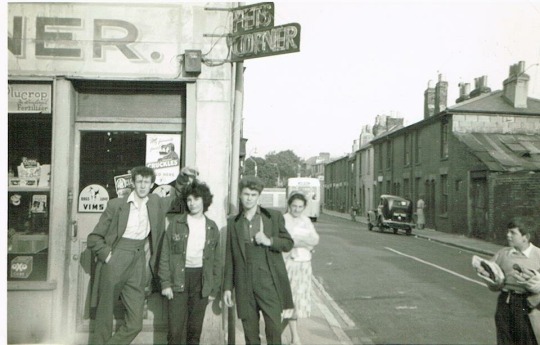
#The Edwardian Teddy Boys#original Teddy Boys#working class fashion#working class styles#styles not for sale#pets corner#Somers Street
0 notes
Text

Last but certainly not least: Dominick the Diesel!
He goes by Nick or Nicky, he’s sunshine incarnate and kinda ditzy, big of heart and dumb off ass
He wants to know where his friends went after he woke up from a COMA?? Wheres Cod? Where’s Perri?
#stex#starlight express#stex oc#starlight express oc#he really is just Wearing clothes#I might make his outfit cooler#he’s a working class diesel he’s got no sense of fashion or racing#no but seriously tho where the hell did his friends go#he’s wade elemental to me that movie changed my brain chemistry#Dominick the diesel
17 notes
·
View notes
Text



more jojo sketches :>
#jjba part 5#jjba#bruno bucciarati#leone abbacchio#guido mista#vinegar doppio#bruabba#my art#the first one is based off of (what i think is) a fashion magazine cover i found on pinterest#i saw it an i immediately was like oh theyre in jojo poses#asjdhlsklkm ok story time i just remembered something#im in a printmaking class this semester and our tables are pretty low so that you can screenprint easily#but last week everyone was working on stuff on laptops#and so my professor goes around looking at everyones work#and every single time he stops to talk to someone he would lean his elbows on the table and like. arch his back#and like his feet were abt 5 whole feet apart. he was in a Stance#ass popped for the world to see#me an my friend were fuckin dying#real life jojo pose...
94 notes
·
View notes
Text
*rocking back and forth in a corner* this too shall pass this too shall pass this too shall pass this too shall pass this too shall pass this too shall pass this too shall pass this too shall pass this too shall pass this too shall pass this too shall pass this too shall pass this too shall pass this too shall pass this too shall pass this too shall pass this too shall pass this too shall pass this too shall pass this too shall pass this too shall pass this too shall pass this too shall pass this too shall pass this too shall pass this too shall pass this too shall pass this too shall pass this too shall pass this too shall pass this too shall pass this too shall pass this too shall pass this too shall pass this too shall pass this too shall pass this too shall pass this too shall pass this too shall pass this too shall pass this too shall pass this too shall pass this too shall pass this too shall pass this too shall pass this too shall pass this too shall pass this too shall pass this too shall pass
#lads I’m in the trenches right now ngl#I’ve got so much fucking work to be done with so little time it’s horrific#like honestly for my english essay I’m not even gonna fucking try anymore I just want to submit it on time I don’t fucking care lmao#fashion is like layers of stress I don’t even want to get into#religion can just suck my cock straight up#art feels like dead weight dragging behind me which sucks because I like art but that class is making me HATE it#anyways yeah I’m so glad this is my last year because I can not fucking do this again#im so stressed I can barely eat lmao#anyways I’m gonna tear my fucking hair out or go live in the woods#senioritis is fucking real PLEASE have better time management than me#I’m gonna melt into the floor#vent
14 notes
·
View notes
Text
7Feb23
Styles’ big win has prompted objection
And asinine Grammys reflection
As his “people like me”
(Like his rotating scene)
Gets spun in the wrong damn direction.
#larry#harry#harry styles#grammys#2023 grammys#album of the year#harry's house#harry at the grammys#as is the norm when harry does a Big Thing that reaches the mainstream#haters are hating#people are up in arms at his speech#'things like this don't happen to people like me'#because all they see in their 30-second glimpses of harry is a rich cis white straight man#there's been think pieces about how he's referencing his working class english upbringing#and there's always been fan speculation that he's referencing his queerness#or that it relates to his boy-band beginnings#but in typical hs fashion it's vague and open-ended#also some of his grammys dancers have revealed a major technical flub in the show#their turntable spun in the opposite direction from what they'd practiced all week#so that's why harry seemed extra nervous and the choreography seemed off#and people are being absolutely nasty about harry beating out beyonce#limerick-hs#february 7#2023#i recommend laying low#stay off mainstream algorithm socials for a few days#until the normies go back to reading deuxmoi
58 notes
·
View notes